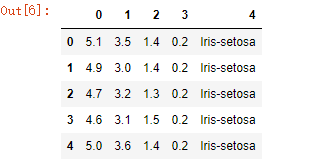**
决策树案例:鸢尾花数据分类
**



import numpy as np
import pandas as pd
import matplotlib.pyplot as plt
import matplotlib as mpl
import warnings
from sklearn import tree #决策树
from sklearn.tree import DecisionTreeClassifier #分类树
from sklearn.model_selection import train_test_split#测试集和训练集
from sklearn.pipeline import Pipeline #管道
from sklearn.feature_selection import SelectKBest #特征选择
from sklearn.feature_selection import chi2 #卡方统计量
from sklearn.preprocessing import MinMaxScaler #数据归一化
from sklearn.decomposition import PCA #主成分分析
from sklearn.model_selection import GridSearchCV #网格搜索交叉验证,用于选择最优的参数
## 设置属性防止中文乱码
mpl.rcParams['font.sans-serif'] = [u'SimHei']
mpl.rcParams['axes.unicode_minus'] = False
warnings.filterwarnings('ignore', category=FutureWarning)
iris_feature_E = 'sepal length', 'sepal width', 'petal length', 'petal width'
iris_feature_C = '花萼长度', '花萼宽度', '花瓣长度', '花瓣宽度'
iris_class = 'Iris-setosa', 'Iris-versicolor', 'Iris-virginica'
#读取数据
path = './datas/iris.data'
data = pd.read_csv(path, header=None)
x=data[list(range(4))]#获取X变量
y=pd.Categorical(data[4]).codes#把Y转换成分类型的0,1,2
print("总样本数目:%d;特征属性数目:%d" % x.shape)
总样本数目:150;特征属性数目:4
x.head(1)

y
array([0, 0, 0, 0, 0, 0, 0, 0, 0, 0, 0, 0, 0, 0, 0, 0, 0, 0, 0, 0, 0, 0,
0, 0, 0, 0, 0, 0, 0, 0, 0, 0, 0, 0, 0, 0, 0, 0, 0, 0, 0, 0, 0, 0,
0, 0, 0, 0, 0, 0, 1, 1, 1, 1, 1, 1, 1, 1, 1, 1, 1, 1, 1, 1, 1, 1,
1, 1, 1, 1, 1, 1, 1, 1, 1, 1, 1, 1, 1, 1, 1, 1, 1, 1, 1, 1, 1, 1,
1, 1, 1, 1, 1, 1, 1, 1, 1, 1, 1, 1, 2, 2, 2, 2, 2, 2, 2, 2, 2, 2,
2, 2, 2, 2, 2, 2, 2, 2, 2, 2, 2, 2, 2, 2, 2, 2, 2, 2, 2, 2, 2, 2,
2, 2, 2, 2, 2, 2, 2, 2, 2, 2, 2, 2, 2, 2, 2, 2, 2, 2], dtype=int8)
data.head(5)

#数据进行分割(训练数据和测试数据)
x_train1, x_test1, y_train1, y_test1 = train_test_split(x, y, train_size=0.8, random_state=14)
x_train, x_test, y_train, y_test = x_train1, x_test1, y_train1, y_test1
print ("训练数据集样本数目:%d, 测试数据集样本数目:%d" % (x_train.shape[0], x_test.shape[0]))
## 因为需要体现以下是分类模型,因为DecisionTreeClassifier是分类算法,要求y必须是int类型
y_train = y_train.astype(np.int)
y_test = y_test.astype(np.int)
训练数据集样本数目:120, 测试数据集样本数目:30
y_train
array([0, 1, 1, 0, 1, 0, 2, 1, 2, 1, 2, 0, 0, 1, 2, 2, 0, 0, 0, 1, 0, 0,
2, 2, 1, 2, 2, 0, 1, 2, 1, 1, 2, 1, 1, 2, 1, 1, 1, 1, 1, 1, 1, 2,
2, 0, 0, 2, 0, 2, 0, 0, 2, 1, 0, 1, 2, 2, 2, 1, 1, 2, 1, 2, 2, 2,
0, 2, 1, 1, 0, 2, 1, 1, 1, 1, 1, 0, 0, 0, 0, 1, 2, 2, 0, 2, 0, 1,
2, 0, 1, 0, 0, 2, 2, 2, 0, 2, 2, 1, 1, 0, 2, 2, 0, 2, 1, 0, 2, 0,
0, 0, 2, 1, 2, 2, 1, 0, 1, 2])
#数据标准化
#StandardScaler (基于特征矩阵的列,将属性值转换至服从正态分布)
#标准化是依照特征矩阵的列处理数据,其通过求z-score的方法,将样本的特征值转换到同一量纲下
#常用与基于正态分布的算法,比如回归
#数据归一化
#MinMaxScaler (区间缩放,基于最大最小值,将数据转换到0,1区间上的)
#提升模型收敛速度,提升模型精度
#常见用于神经网络
#Normalizer (基于矩阵的行,将样本向量转换为单位向量)
#其目的在于样本向量在点乘运算或其他核函数计算相似性时,拥有统一的标准
#常见用于文本分类和聚类、logistic回归中也会使用,有效防止过拟合
ss = MinMaxScaler()
#用标准化方法对数据进行处理并转换
## scikit learn中模型API说明:
### fit: 模型训练;基于给定的训练集(X,Y)训练出一个模型;该API是没有返回值;eg: ss.fit(X_train, Y_train)执行后ss这个模型对象就训练好了
### transform:数据转换;使用训练好的模型对给定的数据集(X)进行转换操作;一般如果训练集进行转换操作,那么测试集也需要转换操作;这个API只在特征工程过程中出现
### predict: 数据转换/数据预测;功能和transform一样,都是对给定的数据集X进行转换操作,只是transform中返回的是一个新的X, 而predict返回的是预测值Y;这个API只在算法模型中出现
### fit_transform: fit+transform两个API的合并,表示先根据给定的数据训练模型(fit),然后使用训练好的模型对给定的数据进行转换操作
x_train = ss.fit_transform(x_train)
x_test = ss.transform(x_test)
print ("原始数据各个特征属性的调整最小值:",ss.min_)
print ("原始数据各个特征属性的缩放数据值:",ss.scale_)
原始数据各个特征属性的调整最小值: [-1.19444444 -0.83333333 -0.18965517 -0.04166667]
原始数据各个特征属性的缩放数据值: [0.27777778 0.41666667 0.17241379 0.41666667]
#特征选择:从已有的特征中选择出影响目标值最大的特征属性
#常用方法:{ 分类:F统计量、卡方系数,互信息mutual_info_classif
#{ 连续:皮尔逊相关系数 F统计量 互信息mutual_info_classif
#SelectKBest(卡方系数)
#在当前的案例中,使用SelectKBest这个方法从4个原始的特征属性,选择出来3个
ch2 = SelectKBest(chi2,k=3)
#K默认为10
#如果指定了,那么就会返回你所想要的特征的个数
x_train = ch2.fit_transform(x_train, y_train)#训练并转换
x_test = ch2.transform(x_test)#转换
select_name_index = ch2.get_support(indices=True)
print ("对类别判断影响最大的三个特征属性分布是:",ch2.get_support(indices=False))
print(select_name_index)
对类别判断影响最大的三个特征属性分布是: [ True False True True]
[0 2 3]
#降维:对于数据而言,如果特征属性比较多,在构建过程中,会比较复杂,这个时候考虑将多维(高维)映射到低维的数据
#常用的方法:
#PCA:主成分分析(无监督)
#LDA:线性判别分析(有监督)类内方差最小,人脸识别,通常先做一次pca
pca = PCA(n_components=2)#构建一个pca对象,设置最终维度是2维
# #这里是为了后面画图方便,所以将数据维度设置了2维,一般用默认不设置参数就可以
x_train = pca.fit_transform(x_train)#训练并转换
x_test = pca.transform(x_test)#转换
#模型的构建
model = DecisionTreeClassifier(criterion='entropy',random_state=0)#另外也可选gini
#模型训练
model.fit(x_train, y_train)
#模型预测
y_test_hat = model.predict(x_test)
#模型结果的评估
y_test2 = y_test.reshape(-1)
result = (y_test2 == y_test_hat)
print ("准确率:%.2f%%" % (np.mean(result) * 100))
#实际可通过参数获取
print ("Score:", model.score(x_test, y_test))#准确率
print ("Classes:", model.classes_)
print("获取各个特征的权重:", end='')
print(model.feature_importances_)
准确率:96.67%
Score: 0.9666666666666667
Classes: [0 1 2]
获取各个特征的权重:[0.93420127 0.06579873]
#画图
N = 100 #横纵各采样多少个值
x1_min = np.min((x_train.T[0].min(), x_test.T[0].min()))
x1_max = np.max((x_train.T[0].max(), x_test.T[0].max()))
x2_min = np.min((x_train.T[1].min(), x_test.T[1].min()))
x2_max = np.max((x_train.T[1].max(), x_test.T[1].max()))
t1 = np.linspace(x1_min, x1_max, N)
t2 = np.linspace(x2_min, x2_max, N)
x1, x2 = np.meshgrid(t1, t2) # 生成网格采样点
x_show = np.dstack((x1.flat, x2.flat))[0] #测试点
y_show_hat = model.predict(x_show) #预测值
y_show_hat = y_show_hat.reshape(x1.shape) #使之与输入的形状相同
print(y_show_hat.shape)
y_show_hat[0]
(100, 100)
array([0, 0, 0, 0, 0, 0, 0, 0, 0, 0, 0, 0, 0, 0, 0, 0, 0, 0, 0, 0, 0, 0,
0, 0, 0, 0, 1, 1, 1, 1, 1, 1, 1, 1, 1, 1, 1, 1, 1, 1, 1, 1, 1, 1,
1, 1, 1, 1, 1, 1, 1, 1, 1, 1, 1, 1, 1, 1, 1, 1, 1, 1, 1, 1, 1, 1,
1, 1, 1, 1, 2, 2, 2, 2, 2, 2, 2, 2, 2, 2, 2, 2, 2, 2, 2, 2, 2, 2,
2, 2, 2, 2, 2, 2, 2, 2, 2, 2, 2, 2])
#画图
plt_light = mpl.colors.ListedColormap(['#A0FFA0', '#FFA0A0', '#A0A0FF'])
plt_dark = mpl.colors.ListedColormap(['g', 'r', 'b'])
plt.figure(facecolor='w')
## 画一个区域图
plt.pcolormesh(x1, x2, y_show_hat, cmap=plt_light)
# 画测试数据的点信息
plt.scatter(x_test.T[0], x_test.T[1], c=y_test.ravel(), edgecolors='k', s=150, zorder=10, cmap=plt_dark, marker='*') # 测试数据
# 画训练数据的点信息
plt.scatter(x_train.T[0], x_train.T[1], c=y_train.ravel(), edgecolors='k', s=40, cmap=plt_dark) # 全部数据
plt.xlabel(u'特征属性1', fontsize=15)
plt.ylabel(u'特征属性2', fontsize=15)
plt.xlim(x1_min, x1_max)
plt.ylim(x2_min, x2_max)
plt.grid(True)
plt.title(u'鸢尾花数据的决策树分类', fontsize=18)
plt.show()

#参数优化
pipe = Pipeline([
('mms', MinMaxScaler()),
('skb', SelectKBest(chi2)),
('pca', PCA()),
('decision', DecisionTreeClassifier(random_state=0))
])
# 参数
parameters = {
"skb__k": [1,2,3,4],
"pca__n_components": [0.5,0.99],#设置为浮点数代表主成分方差所占最小比例的阈值,这里不建议设置为数值,思考一下?
"decision__criterion": ["gini", "entropy"],
"decision__max_depth": [1,2,3,4,5,6,7,8,9,10]
}
#数据
x_train2, x_test2, y_train2, y_test2 = x_train1, x_test1, y_train1, y_test1
#模型构建:通过网格交叉验证,寻找最优参数列表, param_grid可选参数列表,cv:进行几折交叉验证
gscv = GridSearchCV(pipe, param_grid=parameters,cv=3)
#模型训练
gscv.fit(x_train2, y_train2)
#算法的最优解
print("最优参数列表:", gscv.best_params_)
print("score值:",gscv.best_score_)
print("最优模型:", end='')
print(gscv.best_estimator_)
#预测值
y_test_hat2 = gscv.predict(x_test2)
最优参数列表: {‘decision__criterion’: ‘gini’, ‘decision__max_depth’: 4, ‘pca__n_components’: 0.99, ‘skb__k’: 3}
score值: 0.95
最优模型:Pipeline(steps=[(‘mms’, MinMaxScaler(copy=True, feature_range=(0, 1))), (‘skb’, SelectKBest(k=3, score_func=<function chi2 at 0x000000073911B9D8>)), (‘pca’, PCA(copy=True, iterated_power=‘auto’, n_components=0.99, random_state=None,
svd_solver=‘auto’, tol=0.0, whiten=False)), (‘decision’, DecisionTreeClass…split=2, min_weight_fraction_leaf=0.0,
presort=False, random_state=0, splitter=‘best’))])
最优参数列表: {'decision__criterion': 'gini', 'decision__max_depth': 4, 'pca__n_components': 0.99, 'skb__k': 3}
score值: 0.95
最优模型:Pipeline(steps=[('mms', MinMaxScaler(copy=True, feature_range=(0, 1))), ('skb', SelectKBest(k=3, score_func=<function chi2 at 0x000000073911B9D8>)), ('pca', PCA(copy=True, iterated_power='auto', n_components=0.99, random_state=None,
svd_solver='auto', tol=0.0, whiten=False)), ('decision', DecisionTreeClass...split=2, min_weight_fraction_leaf=0.0,
presort=False, random_state=0, splitter='best'))])
正确率: 0.9666666666666667
#基于原始数据前3列比较一下决策树在不同深度的情况下错误率
#基于原始数据前3列比较一下决策树在不同深度的情况下错误率
### TODO: 将模型在训练集上的错误率也画在图中
x_train4, x_test4, y_train4, y_test4 = train_test_split(x.iloc[:, :2], y, train_size=0.7, random_state=14)
depths = np.arange(1, 15)
err_list = []
for d in depths:
clf = DecisionTreeClassifier(criterion='entropy', max_depth=d, min_samples_split=10)#仅设置了这二个参数,没有对数据进行特征选择和降维,所以跟前面得到的结果不同
clf.fit(x_train4, y_train4)
## 计算的是在训练集上的模型预测能力
score = clf.score(x_test4, y_test4)
err = 1 - score
err_list.append(err)
print("%d深度,测试集上正确率%.5f" % (d, clf.score(x_train4, y_train4)))
print("%d深度,训练集上正确率%.5f\n" % (d, score))
## 画图
plt.figure(facecolor='w')
plt.plot(depths, err_list, 'ro-', lw=3)
plt.xlabel(u'决策树深度', fontsize=16)
plt.ylabel(u'错误率', fontsize=16)
plt.grid(True)
plt.title(u'决策树层次太多导致的拟合问题(欠拟合和过拟合)', fontsize=18)
plt.show()
正确率: 0.9666666666666667
#基于原始数据前3列比较一下决策树在不同深度的情况下错误率
### TODO: 将模型在训练集上的错误率也画在图中
x_train4, x_test4, y_train4, y_test4 = train_test_split(x.iloc[:, :2], y, train_size=0.7, random_state=14)
depths = np.arange(1, 15)
err_list = []
for d in depths:
clf = DecisionTreeClassifier(criterion='entropy', max_depth=d, min_samples_split=10)#仅设置了这二个参数,没有对数据进行特征选择和降维,所以跟前面得到的结果不同
clf.fit(x_train4, y_train4)
## 计算的是在训练集上的模型预测能力
score = clf.score(x_test4, y_test4)
err = 1 - score
err_list.append(err)
print("%d深度,测试集上正确率%.5f" % (d, clf.score(x_train4, y_train4)))
print("%d深度,训练集上正确率%.5f\n" % (d, score))
## 画图
plt.figure(facecolor='w')
plt.plot(depths, err_list, 'ro-', lw=3)
plt.xlabel(u'决策树深度', fontsize=16)
plt.ylabel(u'错误率', fontsize=16)
plt.grid(True)
plt.title(u'决策树层次太多导致的拟合问题(欠拟合和过拟合)', fontsize=18)
plt.show()
1深度,测试集上正确率0.66667
1深度,训练集上正确率0.57778
2深度,测试集上正确率0.71429
2深度,训练集上正确率0.71111
3深度,测试集上正确率0.80000
3深度,训练集上正确率0.75556
4深度,测试集上正确率0.81905
4深度,训练集上正确率0.75556
5深度,测试集上正确率0.81905
5深度,训练集上正确率0.71111
6深度,测试集上正确率0.85714
6深度,训练集上正确率0.66667
7深度,测试集上正确率0.85714
7深度,训练集上正确率0.66667
8深度,测试集上正确率0.85714
8深度,训练集上正确率0.66667
9深度,测试集上正确率0.86667
9深度,训练集上正确率0.71111
10深度,测试集上正确率0.86667
10深度,训练集上正确率0.71111
11深度,测试集上正确率0.87619
11深度,训练集上正确率0.66667
12深度,测试集上正确率0.86667
12深度,训练集上正确率0.71111
13深度,测试集上正确率0.86667
13深度,训练集上正确率0.71111
14深度,测试集上正确率0.86667
14深度,训练集上正确率0.71111

























 1万+
1万+











 被折叠的 条评论
为什么被折叠?
被折叠的 条评论
为什么被折叠?










